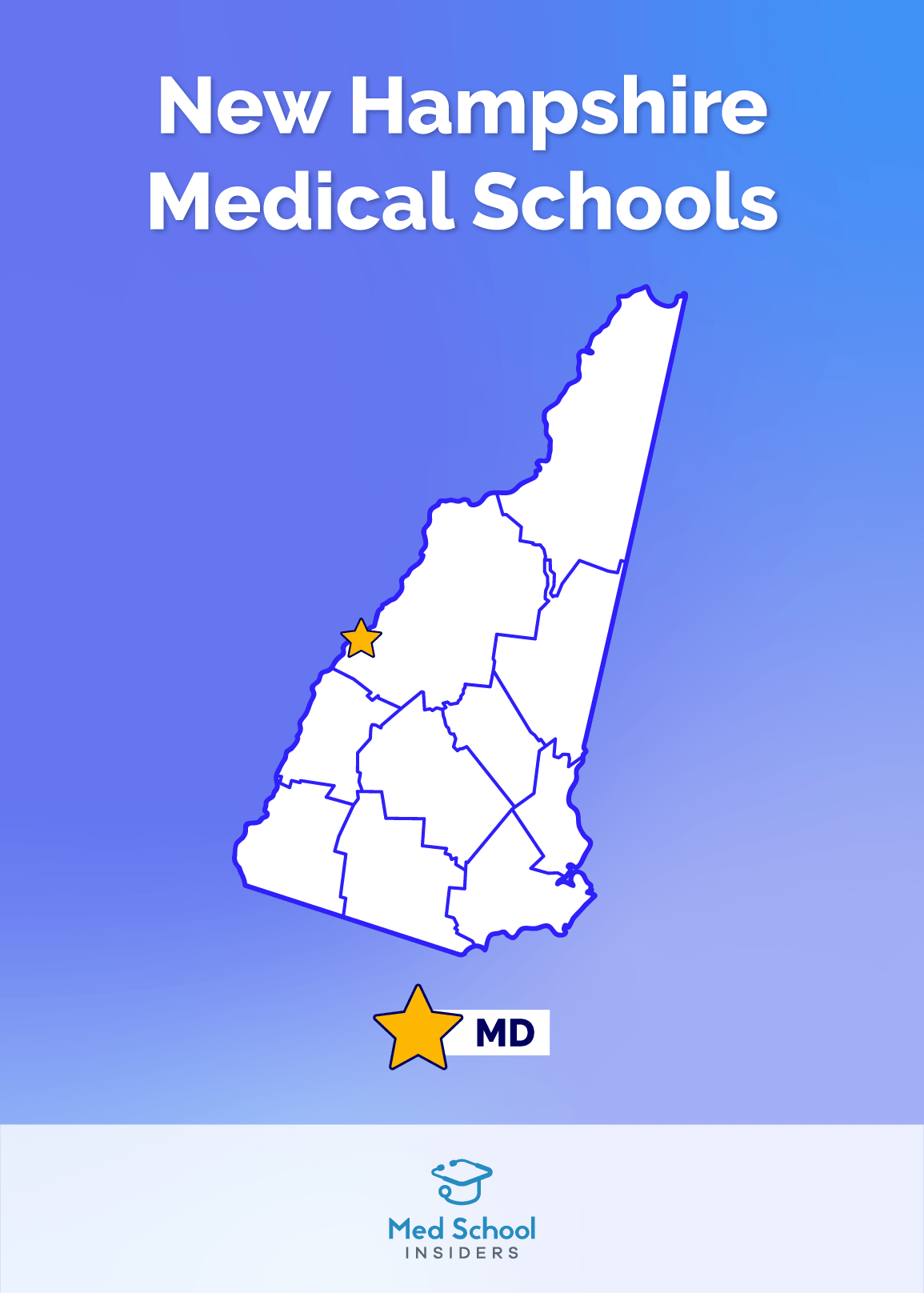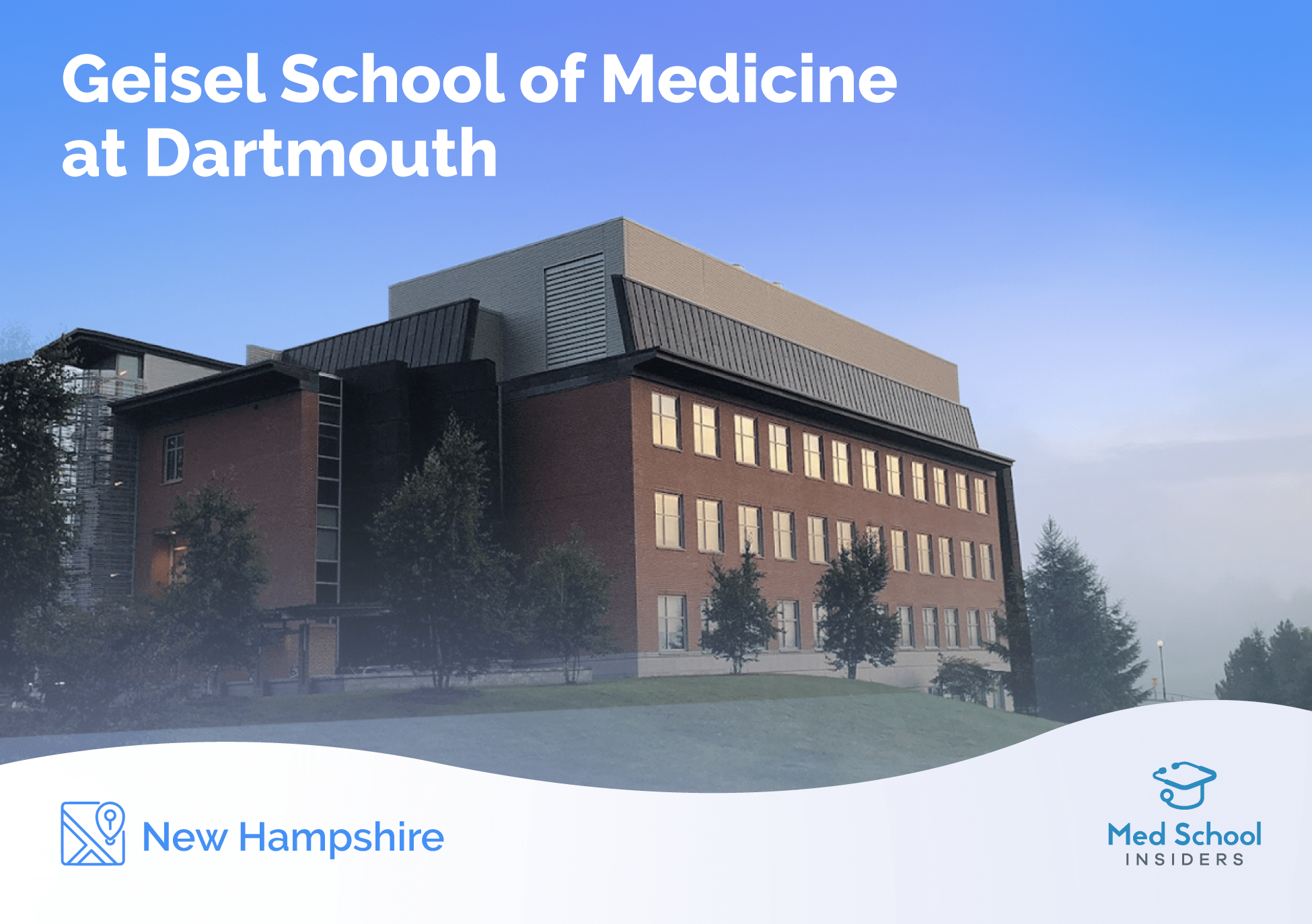Are you considering applying to medical school in New Hampshire? The Granite State is known for its rich history, remarkable natural landscapes, dazzling fall foliage, a plethora of outdoor activities, and some of the best education in the country, from public school all the way up to grad school.
But what’s it like to attend medical school in the “Live Free or Die” state, and how do you get accepted?
In this post, we’ll break down everything you need to know about going to medical school in New Hampshire, including how many schools it has, what it’s like to live there, how to apply, and tips for gaining acceptance to medical school in New Hampshire.
Applying to medical school in other states? Explore our comprehensive State Guide series, which provides an in-depth look at the application process in various states across the country.
How Many Medical Schools Are in New Hampshire?
There is only one allopathic medical school in New Hampshire, and no osteopathic schools.
List of Medical Schools in New Hampshire
Allopathic Medical Schools in New Hampshire (MD)
- Geisel School of Medicine at Dartmouth
Osteopathic Medical Schools in New Hampshire (DO)
There are currently no osteopathic medical schools in New Hampshire and only one in New England. The closest osteopathic school, the University of New England College of Osteopathic Medicine (UNECOM), is in Biddeford, Maine.
New Hampshire Medical School Location
Geisel School of Medicine at Dartmouth is located in Hanover, New Hampshire. Hanover is a college town with a population of approximately 8,520, which is considerably smaller than the larger cities in the state. It’s home to Dartmouth College and the US Army Corps of Engineers Cold Regions Research and Engineering Laboratory. The scenic Appalachian Trail also crosses through the town.
By contrast, Manchester, New Hampshire’s most populous city, has a population of 115,000, Nashua’s is 91,000, and Concord’s is 45,000. These cities are all located between 20 and 45 minutes from each other, and Hanover is about an hour and fifteen to an hour and a half drive away from all of these larger cities.

How Much Is Medical School in New Hampshire?
So, how much does medical school cost in New Hampshire?
New Hampshire Tuition Costs (2025 Data From MSAR)
| Medical School | Yearly Tuition In-State | Yearly Tuition Out-of-State |
|---|---|---|
| Geisel School of Medicine | $72,327 | $72,327 |
View the most recent AAMC tuition data.
- Additional fees not included.
Additionally, you need to consider the cost of medical school applications, which can add up across primary fees, secondary fees, exam fees, study resources, and interview travel costs.
Plus, there are many other factors to consider, including housing, transportation, food, exercise, and events. New Hampshire balances having no state income or sales tax with extremely high property taxes and a high cost of living. That said, no sales tax does make groceries more affordable.
It also depends on where you’re coming from. While the Granite State’s cost of living is lower than that of its New England neighbors, it can still get expensive. If you’re from Indiana, New Hampshire is expensive, but if you’re from Massachusetts, it will be cheaper.
Geisel School of Medicine at Dartmouth
Located in Hanover, New Hampshire, Ivy League Dartmouth College was founded almost two and a half centuries ago in 1797. It’s home to the fourth-oldest medical school in the US.
Originally named the Dartmouth Medical School until 2012, the school was renamed the Audrey and Theodor Geisel School of Medicine after the internationally beloved children’s author and cartoonist Dr. Seuss, whose real name was Theodor Seuss Geisel, an alumnus of the Class of 1925 and the school’s most generous donor.
Geisel School of Medicine is known for its history of firsts, including opening the nation’s first building used exclusively for medical education, incorporating the use of the stethoscope in its medical curriculum beginning in 1838, and pioneering the use of the clinical X-ray in 1896.
Geisel’s Mission Statement is as follows:
“We address the world’s health problems through research and discovery, the evaluation and improvement of systems of healthcare, and the education of the best future physicians and scientists.”
And it’s followed by their Vision:
- to be the medical school that sets the standard for educating physicians, scientists, and teachers who will act in concert to improve health locally and globally;
- to build a diverse and inclusive community in order to enrich learning, foster innovation and tackle the most vexing challenges in health care;
- to generate and disseminate new knowledge through research and education that leads to new and more effective therapies and to systematic improvement of health care delivery.
Geisel receives over 8,000 applications and interviews about 650 applicants each year for 92 positions in the entering class.
Median Academic Scores of Matriculants:
- Median GPA: 3.89
- Median MCAT: 516
Student Experience at Geisel
Being on the more rural side, the school community becomes central to a student’s experience. Fortunately, the community is incredibly warm, welcoming, and intimate.
Students regularly have dinners hosted by the faculty, have several sporting events annually both within the school and against other schools, and the medical school students, staff, and faculty are significantly involved in community service efforts.
One example is the “Swenson Cup,” which is a soccer game between the first and second years that is refereed by a faculty member, Dr. Swenson, and attended by staff and faculty who bring their families and pets along for the experience.
Our Insider contributor for this guide firmly believes Geisel attracts a certain type of genuinely nice person. For example, when they and their classmates arrived in Hanover and were scrambling to sort out housing, etc., a class-wide chat was created, and classmates offered the use of their trucks to help each other move, donated extra kitchen utensils and appliances, and committed other small acts of kindness to really help everyone settle in.
An example of how this lives on even beyond graduation is how the alumni paid for each student’s stethoscope during first year, and each came with a personalized, handwritten letter from an alumnus.
In preclinical years, students have the opportunity to grow close to each other because of how rural Hanover is. Students routinely have board game nights, host potlucks, watch TV shows and movies together, play weekly soccer, and much more.
Geisel MD Curriculum
Geisel offers an integrated four-year medical curriculum that’s designed to provide students with an exceptional foundation in the basic sciences, diverse clinical experiences, and an environment built on teamwork and inter-professional collaboration—something that’s supported by the small class size and intimate learning community.
Geisel’s curriculum has three learning phases:
Phase 1: Foundations of Medicine
Phase 1 is made up of a broad range of courses organized into blocks, including cardiovascular and respiratory medicine, neurology and psychiatry, reproductive medicine and endocrinology, and much more.
The courses are also highly integrated with longitudinal topics like Patients & Populations, which is designed to empower students to become change agents who will make a difference in the health of communities and populations, as well as problem-based learning (PBL) cases that prioritize clinical relevance.
The grading system in Phase 1 is Pass/Fail.
Phase 2: Clinical Immersion
Phase 2 begins in second year and sees students participate in six required core clerkships: internal medicine, OB/GYN, surgery, psychiatry, pediatrics, and family medicine.
Clerkships are four to eight weeks and are completed in an incredibly wide range of clinical learning sites, such as its affiliated academic medical centers, the Veterans Affairs Medical Center, and Dartmouth-Hitchcock Medical Center, which is the only level 1 trauma center in the state and cares for a significant portion of patients across New England. It’s also home to the only air ambulance service in the state, which covers over 2 million square feet.
Clinical learning sites also include regional teaching hospitals and office practices, as well as medical centers and hospitals across the country, including Arizona, New Mexico, Florida, California, and more.
Phase 2 also allows students to take up to eight weeks of clinical electives along with the required six clerkships.
Phase 3: Exploration and Differentiation
Phase 3 begins in April of your third year. You’re required to take two four-week clerkships in neurology and advanced ambulatory medicine in addition to at least one advanced four-week sub-internship in your field of choice. Therefore, you’ll have five to six months to explore career choices through electives and sub-internships before you need to apply to residency.
The keyword here is explore. You can choose from opportunities on campus, across the country, and around the world. You can also design your own elective with the help of a faculty member. There is also flexibility in the order in which you complete your required clerkships. For example, students interested in neurology can explore the field early by completing the clerkship during their third year.
For example, our Insider contributor for this article completed core rotations in three sites in New Hampshire, as well as Augusta, Maine, San Francisco, California, Jacksonville, Florida, and Hartford, Connecticut. It is truly an immense opportunity to train across numerous sites that vary in geography, type of patients served, health system used, and size, while meeting people from diverse backgrounds.
At the end of your fourth year, you’ll return to campus for a capstone course designed to help you excel in residency and beyond.
The grading system for clinical clerkships is as follows: Honors, High Pass, Pass, and Fail.
University of New Hampshire In-State vs. Out-of-State Applicants
Geisel School of Medicine accepts both in-state and out-of-state applicants, but receives the vast majority of its applications from out-of-state applicants.
In 2024, Geisel had 65 in-state applicants and 7728 out-of-state applicants. By far, the majority of matriculants were from out-of-state (82 out-of-state and 3 in-state).
| In-state | Out-of-state | International | Total | |
|---|---|---|---|---|
| Verified Applications | 65 | 7728 | 712 | 8505 |
| Interviewed | 9 | 568 | 34 | 611 |
| Matriculated | 4 | 82 | 10 | 96 |
Approximately 6.2% of in-state applicants matriculated to Geisel School of Medicine compared to 1.1% of out-of-state applicants.
What It’s Like to Go to Medical School in New Hampshire
New Hampshire is located in the New England region of the United States. It shares a northern border with the Canadian province of Quebec, a southern border with Massachusetts, a western border with Vermont, and an eastern border with Maine and the Gulf of Maine.
It’s nicknamed The Granite State for its many granite formations and quarries, and the state’s motto is “Live Free or Die,” which harkens back to the days of the Revolutionary War.
The geography of New Hampshire is marked by the White Mountains range that spans the north central area of the state, hundreds of lakes, ponds, extensive rivers, and the second largest percentage of timberland area in the entire US. Mount Washington, the tallest mountain in the northeastern United States, is located in the White Mountains range.
New Hampshire has the smallest ocean coastline of any coastal state at approximately 18 miles long, but even with such a short coastline, New Hampshire’s Hampton Beach remains an extremely popular vacation destination for residents and tourists alike.
New Hampshire is a popular destination for fans of the outdoors, with many visitors coming to ski on some of the highest slopes on the East Coast, hike the Appalachian Trail, kick back and relax at lakeside cottages, and soak in the red, orange, and gold kaleidoscope of changing fall foliage. For medical students with a passion for outdoor activities, New Hampshire should fit like a glove (… which is very necessary in the winter).
New Hampshire has a humid continental climate and experiences four distinct seasons. Short, cool summers, autumns with beautiful foliage, and long, snowy winters are the norm each year. The state experiences some extreme weather events, such as tropical cyclones, severe winter storms, coastal storms, and cold waves.
New Hampshire is one of the ten smallest states in terms of area, but it is densely populated. For every square mile of land in the state, there are 147 people. Of the approximately 1.3 million residents of New Hampshire, 94% are white. However, there is significant socioeconomic diversity, and the vast geographic catchment area of the hospital leads to an incredible diversity of pathologies and diseases encountered.
New Hampshire is a very rural state, so there are limited nightlife options, and access to a big city isn’t easy. Boston is around a two-hour drive or a three-hour coach, and New York City is about a five-hour coach. The Amtrak stops close by at the White River Junction stop, but routes are often quite slow.
There’s a remarkably low crime rate in New Hampshire, which may be ideal for students from smaller towns or those who are moving out on their own for the first time. In 2022, the state ranked in the bottom three of all fifty states for both property crime and violent crime. The violent crime rate is 125.6 incidents per 100,000 residents, well below the national average.
New Hampshire has intercity buses and a long-distance passenger rail service that handles public transportation for residents without a vehicle. However, since it’s so rural, if you plan to see more of the state than just Hanover, you’ll likely need your own vehicle to get around.
The busiest airport in the state is the Manchester-Boston Regional Airport, but for international service, you need to travel to Boston’s Logan International Airport.
How to Apply to the Geisel School of Medicine at Dartmouth 
To apply to the Geisel School of Medicine, the only allopathic medical school in New Hampshire, you will use the American Medical College Application Service (AMCAS), the AAMC’s centralized medical school application processing service. It’s the primary application method for first-year entering classes for the vast majority of US medical schools.
Here’s what you need to know about the Geisel School of Medicine application process.
1 | Application Requirements
Many pieces come together to form your primary application.
To be a compelling applicant, you’ll need your college transcripts, a high GPA and MCAT score, a cohesive, narrative-driven personal statement, glowing letters of recommendation, and a diverse and detailed Work and Activities section. Making each of these components as intriguing as possible requires a significant time investment.
You may also have to complete a situational judgment test, either the AAMC PREview exam or the Casper test administered by Acuity Insights.
However, at the latest publish date of this article, Geisel School of Medicine does not require its applicants to take either Casper or PREview.
Planning to apply to more schools than just Geisel? Check out our guides to what schools require AAMC PREview and what medical schools require Casper.
After you submit your primary application, you will receive a secondary application from Geisel two to four weeks later—but only if you scored 503 or higher on your MCAT.
That’s right: Geisel has an MCAT score cutoff of 503.
Unlike the primary application, you will submit your secondary directly to the school. The secondary application fee for Geisel is $130.
Geisel School of Medicine Secondary Application Questions
The following four questions were asked on Geisel’s 2024-2025 secondary application.
1. Please indicate your plans for the 2024-2025 academic year. If in school, please list your courses.
If working, let us know something about the nature of your job.
If your plans or courses change subsequently, please inform the Admissions Office by email at [email protected]. (no word limit)
2. Please reflect on your primary application and share something not addressed elsewhere that would be helpful to the Admissions Committee as we review your file. (no word limit)
3. What aspects of the Geisel School of Medicine draw you to apply? Please include the characteristics and strengths you will bring to our program and how you hope to contribute to our community. (no word limit)
4. Geisel School of Medicine values social justice and diversity in all its forms. Reflect on a situation where you were the “other.” (250 words)
If the admissions committee is interested in you after reading your secondary application, you could receive an invitation to interview virtually at any point between the end of August and March of the following year. At the latest publish date of this article, Geisel conducted virtual interviews.
The interview day begins with a welcome from the Associate Dean of Admissions, an information session with the admissions team, a welcome from the Office of Diversity, Inclusion, and Community Engagement, a 20-minute group exercise, and a financial aid presentation.
In the afternoon, you will have two thirty-minute one-on-one interviews with members of the admissions committee. The day will end with closing remarks from the Associate Dean, and then opportunities to connect with current students will happen separately from the scheduled interview day.
Learn more about the complete application process: How to Get Into Medical School: AMCAS Application Process.
2 | Application Deadlines
The AMCAS application opens during the first week of May for the following academic year’s medical school class. For example, to begin medical school in the fall of 2027, you’ll need to start the application process in the spring of 2026. Submissions don’t open at Geisel until the end of May, giving you about a month to prepare your application.
However, the technical deadlines provided by AMCAS and Geisel are not what you need to follow. Every week or month that you delay your application decreases your chance of acceptance.
Applying early, almost as soon as submissions open, is critical to your success.
Geisel, just like every medical school in the US, including osteopathic schools, utilizes rolling admissions. This means applications are reviewed as soon as they are received. Therefore, the fastest applicants receive the first secondaries, and the first to submit their secondaries secure the first interview spots, and these fill up fast.
Secondaries should be prioritized right away and submitted within two weeks (14 days) of receiving them.
The sooner you book and complete your interviews, the better, as medical schools begin sending out acceptances as they start interviewing candidates. **Delaying any aspect of your application could result in someone equally as qualified receiving an acceptance instead of you, simply due to timing.

Keep on top of each of your medical school application deadlines with our comprehensive Medical School Application Timeline and Monthly Schedule. (Updated every application cycle.)
Tips for Acceptance at New Hampshire Medical Schools
1 | The “Other” Secondary Question
One of Geisel’s secondary questions is: “Geisel School of Medicine values social justice and diversity in all its forms. Reflect on a situation where you were the ‘other.’ (250 words)”
Diversity questions can sometimes be intimidating, as applicants who don’t come from a specific ethnocultural or socioeconomic background may feel awkward saying they’ve ever been the “other.” How can they add diversity to a prospective medical school class?
However, diversity and “otherness” aren’t limited to the color of your skin or your religious background. Did you have a non-traditional upbringing growing up? Did you grow up in a single-parent home? Have you lost a close family member or friend? Do you have a disability or a sibling with a disability? Did you need to work from a young age to help support your family? Were you affected by bullying?
There are many, many areas of your life where you may have been treated as the “other.” Stay focused on your story. What aspect of your upbringing or personal identity makes you unique from your peers?
Our Insider contributor for this article, who graduated from Geisel and also served on its admissions committee, says that what this question truly seeks to discover is that you’re a true team player with the humility, empathy, and compassion to become an exceptional and complete physician.
This Is How to Write the Medical School Secondary Diversity Essay.
2 | Understand the Rural, Close-Knit Community
Hanover, where Geisel is located, is a small town with a population of under 10,000 people. It’s a close-knit, rural community, and the admissions committee wants to accept students who share rural values of teamwork and cooperation and are passionate about volunteering their time. They are not looking for cutthroat, competitive gunners who tear others down to make themselves look more impressive.
Throughout your primary and secondary applications, highlight specific moments from your past where you have tangibly demonstrated your ability to be a team player. Did you grow up in a rural environment yourself, or has it always been your dream to leave the big city and move to a small town where everyone knows your name and you know theirs?
It’s also important to note that, as previously mentioned, 94% of the population of New Hampshire is Caucasian, which doesn’t translate to a culturally diverse patient population. However, if you’re hoping to work with more diverse patient populations, Geisel does have clinical learning sites across the country and even internationally.
3 | You’ll Need Your Own Car
New Hampshire is a very rural state. While there are public transit systems, they’re limited, and it’s rare for students in the Granite State not to own their own car.
If you come from a city with a multi-faceted and reliable transit system, this can be a significant transition. If you haven’t learned how to drive yet, that’s one more thing to add to your already extensive to-do list as you apply to medical school.
Bottom Line: Is Going to Medical School in New Hampshire Right for You?

Beyond Geisel’s excellent and unique curriculum and resources, it matters whether or not you enjoy the rural community and environment you’ll call home for the next four or more years.
Pros of Medical School in New Hampshire
- Excellent training for future clinicians
- Geisel is one of the most reputable medical schools in the country
- Faculty and professors who get to know each of you by name and genuinely care about your development
- Supportive classmates
- Access to training sites across the country (and internationally)
- Diversity of patient pathology and socioeconomic background
- Close-knit communities
- Beautiful natural landscapes (coastline, mountains, and lakes)
- Plenty of outdoor activities (hiking, skiing, boating)
- Get to see all four seasons, including fall foliage
- No state income or sales tax
- Affordable groceries
- Very low crime rate
Cons of Medical School in New Hampshire
- Very rural, meaning you’ll need a car as public transportation won’t be enough
- Limited nightlife (it takes several hours to get to a big city)
- High property taxes
- High cost of living
- Housing is expensive and hard to find
- High rates of ticks and Lyme disease
- Cold winters with lots of snow
- Lack of cultural diversity (mostly Caucasian)…
- …Which also translates to a lackluster food scene
Whether you’re eager to study in New Hampshire for its world-class education, rich history, beautiful natural scenery, exciting outdoor activities, close-knit rural setting, or all of the above, the Granite State has plenty to offer. Who knows, soon your own motto may be Live Free or Die!
What Adcoms Are Looking For
The admissions committee at Geisel School of Medicine is looking for well-rounded, compassionate, and community-minded students who will enrich the student body. They aren’t looking for cookie-cutter candidates who are simply checking off boxes.
Med School Insiders can help you design a stand-out application that will get you noticed by the Geisel School of Medicine at Dartmouth College, as well as any schools at the top of your list. We have a wide range of services to suit your specific needs, from one-on-one guidance to application editing to mock interviews.
Whether you need a comprehensive application strategy, detailed essay feedback, or interview preparation, our services are tailored to meet your individual circumstances and goals. Don’t leave your medical school dreams to chance—contact us today to find out how you can transform your application from good to truly memorable.
Thank you to Conner Bridges, MD, from Geisel School of Medicine at Dartmouth, for being our Insider contributor for this guide.










